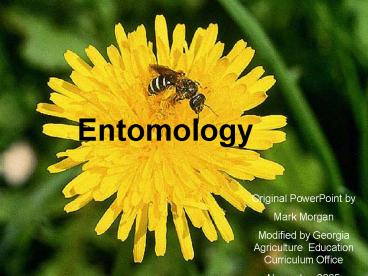Entomology - PowerPoint PPT Presentation
1 / 23
Title:
Entomology
Description:
the branch of zoology that deals with the study of insects. On average there are more than 750,000 species of insects that have been identified worldwide. ... – PowerPoint PPT presentation
Number of Views:86
Avg rating:3.0/5.0
Title: Entomology
1
Entomology
Original PowerPoint by Mark Morgan Modified by
Georgia Agriculture Education Curriculum
Office November 2005
2
- What is Entomology?
- the branch of zoology that deals with the study
of insects
3
- On average there are more than 750,000 species
of insects that have been identified worldwide.
4
- There are only approximately 10,000 species of
insects that are harmful to humans.
5
Problems
- Deadly epidemics of the past have been caused by
diseased organisms carried by insects. - Example Bubonic Plague epidemic that wiped out
the population of Europe in the 14 century was
carried by fleas that infested rodents
6
Classification of insects
- Kingdom
- Phyla
- Class
- Order
- Family
- Genus
- Species
7
- The highest level is the Kingdom
- The most specific is the species level.
- Organisms are usually classified by the genus and
species. - This is called a binomial nomenclature.
8
Six orders of insects
- Orthoptera- which includes the grasshopper and
locust - Hemiptera- which includes the true bugs such as
leaf hoppers and plant bugs - Lepidoptera moths and butterflies
- Homoptera- aphids
9
Contd
- Thysanoptera- thrips
- Coleoptera- which is the largest group of the
insect orders this has beetles
10
How are insects grouped?
- by the way they feed on plants
- by their mouth parts
11
Six Mouth Parts
- Sponging
- Rasping- sucking
- Siphoning
- Chewing-lapping
- Chewing
- Piercing- sucking
12
- Insects have no internal skeleton and they rely
on their hard outer coating, exoskeleton, which
protects their inner organs and supports their
body.
13
Parts of an Insect
- Head
- Thorax
- Abdomen
14
Head
- Has a pair of compound eye and two sensory
appendages called antennae
15
Thorax
- is divided into three segments from which are
attached three pairs of legs
16
Abdomen
- is attached to the thorax
- which will contain more segments
17
Life Cycles
- Incomplete Metamorphosis
- Complete Metamorphosis
18
Incomplete Metamorphosis
- Eggs
- to Early nymph (no wings)
- to late nymph (wings developing)
- Goes to Adult
19
Complete Metamorphosis
- Eggs to
- Larva to
- Pupa to
- Adult
20
What Is a Larva?
- It is when the young insect has soft tubular body
and looks very much like a worm
21
What Is the Pupa Stage?
- The larva matures and will pass through the pupa
stages which is usually a relatively dormant
stage.
22
What is DDT?
- This is a chemical that was discovered by German
name Othmar Zeidler in 1874. - It is a chemical used to reduce the number of
insects in a given area. - Example mosquitoes in the tropics
23
Integrated Pest Management
- Cultural methods
- Insect diseases and predators
- Pheromones
- Release of sterile males
- Insect resistant plants varieties































